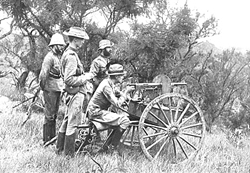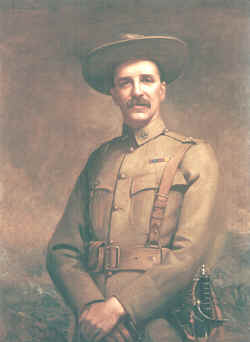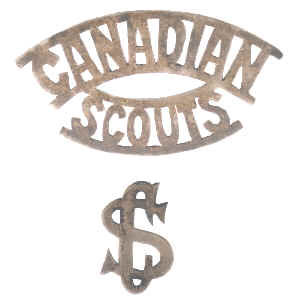 |
| Category: Boer War |

|
|
|
|
|
|
Aussies in The Canadian Scouts |
 |
The 1895 Model Colt machine
gun that the Royal Canadian Dragoons and other Canadian mounted units
adopted after their arrival in South Africa.
It was mounted on a carriage
that could be pulled by a single horse. Here it is operated by a British
team. A.T. Mahan, The South African War |
| Developed by the
celebrated American firearm designer, John Browning, this machine gun
was introduced by the Colt Company of Hartford, Connecticut in 1895.
Like the Maxim gun introduced four years earlier, it operated entirely
by mechanical means. The tapping of a small amount of gas generated by
the combustion of the propellant was diverted to a piston, which drove
back the breech block and cycled the mechanisms to load, fire, and
extract. Unlike the water-cooled
Maxim, this gun was air-cooled. It
had a lower rate of fire, but was of lighter weight and was more easily
handled.
This .30-calibre machine gun quickly
became a favourite of the volunteer mounted infantry units of the
British Army, which found the lightweight weapon a natural compliment to
their fast moving, highly mobile methods of warfare. Doubtless this was
one of the factors influencing the decision of their Canadian
counterparts to dispense with their Maxims in favour of Colts after
their arrival in South Africa.
The legacy of the Canadian experience
with machine guns in South Africa was that the Canadian Expeditionary
Force went to war in 1914 armed with the Colt machine gun. Yet, it was
the next generation of the Maxim design, the heavy Vickers gun, that was
to dominate the static battlefields of that war. |
| Commanding
Officer: Major Arthur L. “Gat” Howard |
 |
An American by
birth, and an officer in the Connecticut National Guard, Howard was sent
north by the Colt Firearms Company to operate a Gatling gun that the
company had loaned to the Canadian Militia for use in the Northwest
Campaign of 1885.
A colourful and charismatic character,
he soon became something of a hero of that campaign, and was given his
nickname "Gat" by the popular press. He stayed in Canada, and
became quite wealthy as a major shareholder in the Dominion Cartridge
Factory.
Howard offered to provide a battery of
four machine guns at his own expense for service in the South African
War. The Department of Militia and Defence refused his offer, although
Howard accepted the position of machine gun officer in the 1st Canadian
Mounted Rifles (later called the Royal Canadian Dragoons). |
| Major Arthur L.
“Gat” Howard, machine gun officer with the Royal Canadian Dragoons
in South Africa, February — December 1900; founder and Commanding
Officer of the Canadian Scouts, December 1900 — February 1901. CWM
85064 Artist Unknown |
Howard, in his
mid-fifties, was an aggressive, fearless leader who fought the Boers at
close quarters.
On one occasion he only escaped
capture at the last moment by detaching the machine gun from its
carriage and carrying it away. |
| Instead of returning home
with his unit in December 1900, Howard organized the Canadian Scouts and
took command of the unit.
He was killed in action on 17 February 1901. Some
claim that he was captured, robbed and then murdered by a Boer.
Major Howard’s impressive military exploits were among the most
dramatic in the history of Canada’s participation in the South African
War.
I am told that Gat Howard gave all his
men the rank of sergeant and paid the difference between a trooper's
and sergeant's pay from his own funds.
|
 |
Charles Joseph Ross
DSO was 2nd in command to "Gat" Howard and took command after his death
until the end of the war. Charles Ross was born in
Orange NSW in 1857.
|
 Howard's
Sergeant, Edward Holland, won the VC that Gat probably would have won at
Leliefontein, 7 Nov 1900, had he not been on leave. The actions that Sgt
Holland carried out at Leliefontein were 100%, dyed-in-the-wool Gat
Howard: mow down a whole raft of your enemies, keep firing until they
get too close for you to get the Dundonald galloping carriage away,
dismount the gun and ride off with it on the nearest horse you can find. Howard's
Sergeant, Edward Holland, won the VC that Gat probably would have won at
Leliefontein, 7 Nov 1900, had he not been on leave. The actions that Sgt
Holland carried out at Leliefontein were 100%, dyed-in-the-wool Gat
Howard: mow down a whole raft of your enemies, keep firing until they
get too close for you to get the Dundonald galloping carriage away,
dismount the gun and ride off with it on the nearest horse you can find.
|
|
History of the Canadian
Scouts |
| The Canadian Scouts,
raised in South Africa in December 1900 and January 1901, was the
brainchild of Lieutenant Arthur L. ("Gat") Howard, the machine
gun officer of the Royal Canadian Dragoons. No doubt reflecting
Howard’s enthusiasm for the weapon, the Canadian Scouts’ armament
included six Colt machine guns, a larger number than normal.
Howard commanded the unit with the
rank of major. Most of the other officers had served as non-commissioned
officers in the second Canadian contingent, among them the former
commanders of the scout sections of the Royal Canadian Dragoons and the
Canadian Mounted Rifles. Howard must have done a good job of marketing
the Canadian reputation as scouts, for the British agreed to pay a
premium for their service of two shillings a day above the customary
rate.
After Howard was killed in action on
17 February 1901, at the age of 55, the unit continued as a corps of
scouts but it evolved into an irregular mounted corps of four squadrons,
a machine gun battery, a troop of Black South African scouts, and a
transport column, in all about 475 men. By this stage, however, most of
the men in its ranks were not Canadians, but included men from
throughout the British Empire.
Known for disdaining standard military
discipline, the Canadian Scouts gained a reputation as a group of
hard-riding, implacable, and death-defying soldiers. They saw plenty of
action and suffered a large number of casualties. While not officially a
Canadian unit, the Scouts never fully lost their Canadian character, and
certainly did nothing to diminish the impressive reputation earned by
more conventional Canadian units.
Some but not all of the information here is from http://www.civilization.ca
(with permission) |
|